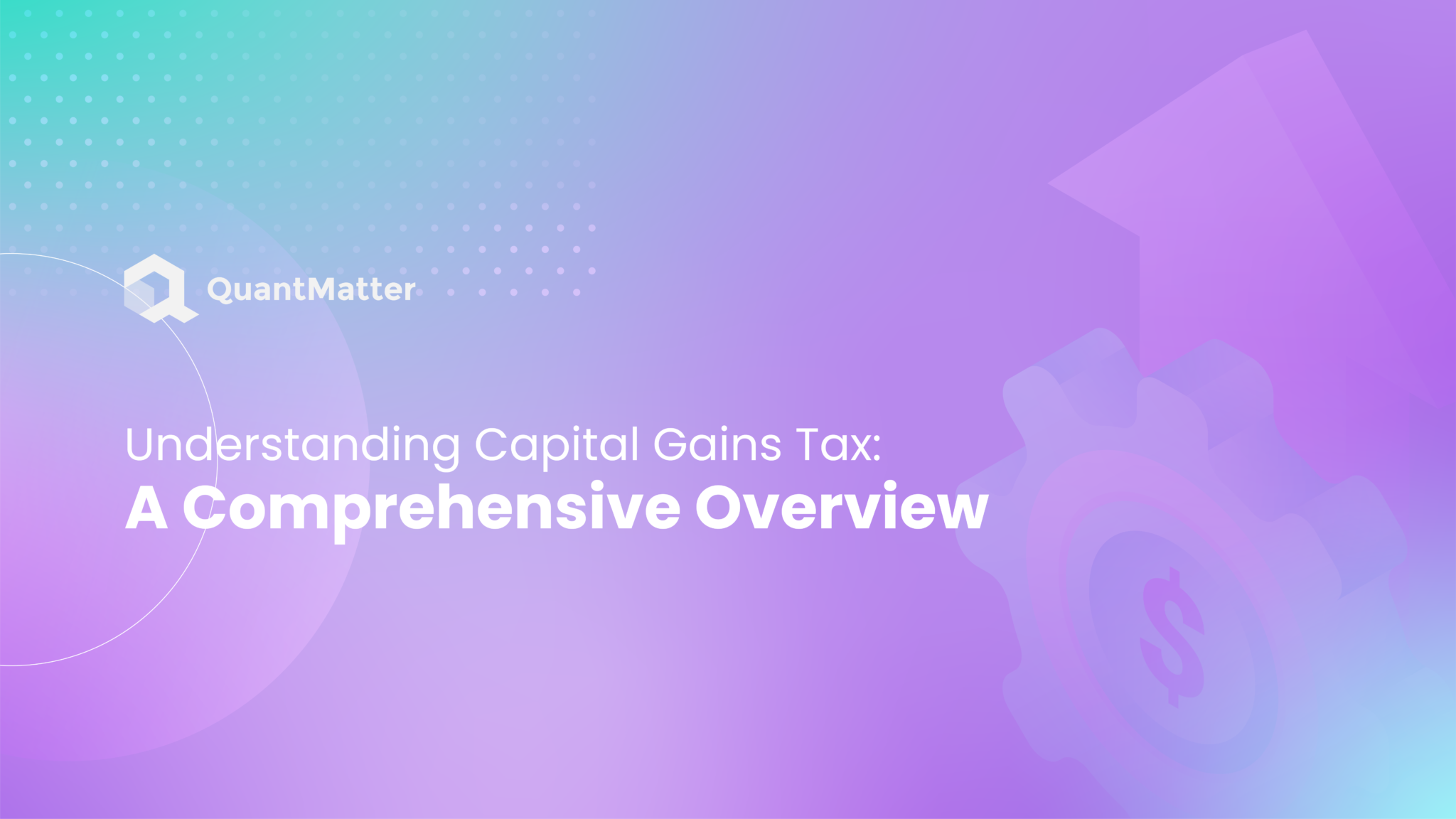
Capital gains tax is a very important part of the financial sphere, affecting both individuals and businesses. The intricate world of capital gains tax requires a deep understanding of the detailed rules, exclusions, and possible strategies that could be deployed to reduce one’s tax burden.
Regardless of whether one is an individual investor focusing on personal finance or a businessperson handling numerous investments in the portfolio, being proactive and informed about capital gain taxes remains critically important to achieving financial success. This is a tax on the gains made from selling capital assets like stocks, real estate or other investments. In this article, we will explore the nuances of capital gains tax, its effects and possible approaches to dealing with such a tax liability.
What is Capital Gains Tax (CGT)?

A capital gains tax is a fiscal arrangement levied on proceeds earned from the disposal of property. This includes stocks, real estate and other investments in general. It is about the difference between what was paid for an asset and its current selling price, otherwise known as the cost basis. This tax liability comes up whenever such an asset is disposed of at a price greater than its initial cost and thus incurs a capital gain. The delineation of capital gains extends into two primary categories: short-term and long-term.
Short-term capital gains are achieved through assets for a period of less than one year, and they trigger taxation based on the ordinary income tax rate. On the flip side, long-term capital gains, which are those arising from assets held for more than one year, generally attract lower and preferential tax rates.
Also Read: Market Maker Options: Definition and How They Make Money
Additionally, jurisdictions differ in their capital gains tax policies; some offer exemptions or deductions for certain assets or only under specific conditions. For instance, the sale of a principal residence might qualify for capital gains tax exclusion up to a certain threshold. Investors in the financial world need to carefully consider how potential capital gains tax may affect their decisions concerning either buying or selling assets. Temporal aspects, such as the timing period and holding periods, can significantly impact the quantum of tax liabilities.
Taxpayers need to keep records and report their income tax returns precisely so they can maintain good standing with current tax laws. Navigating the complexities of capital gains tax requires a careful understanding of how these laws apply to their jurisdiction because regulations can vary greatly even within countries. Therefore, it is very important to stay current with all these regulations while making effective financial plans and avoiding possible tax liabilities.
Apart from the differences between short-term and long-term capital gains, some countries or regions might have more subtle models of rules and incentives to adjust how much a tax on capital gains would affect their economies. In order to promote long-term investment, governments may establish policies that lower tax rates for qualifying substantial capital gains.
On the other hand, short-term capital gains may attract higher tax rates as a way of influencing speculative and short trading activities. Some jurisdictions also offer tax-related incentives for certain kinds of investments, namely those supporting environmental or social causes. Investors must understand these intricacies to correctly position taxes and align their financial strategies in accordance with broader economic goals as well as the objectives of regulators.
6 Investment Strategies for Capital Gains Tax (CGT) Efficiency

Proper handling of capital gains tax is a core aspect of maximizing investment earnings. Here are several strategies to consider:
1. Long-Term Holding
Choosing a long-term holding strategy entails keeping investments for longer periods of time, often more than one year. This approach follows not only a patient and strategic investment philosophy but also has some favorable tax benefits. Investments held for more than one year are subject to long-term capital gains treatment, which in many jurisdictions attracts lower tax rates compared with short- term gains.
This not only cuts immediate taxes but also creates a more advantageous risk-reward equation for investors. Further, long-term holding is especially beneficial for assets that have a past track record of consistent growth since it provides investors with the capacity to realize greater earning power in compounding and reduce short term market forces on tax liabilities. In addition, lower tax rates on longer-term gains generally improve overall portfolio effectiveness and have the potential to substantially increase after-tax returns throughout the investment period.
2. Tax-Loss Harvesting
Tax-loss harvesting is a forward looking tactic where an investor deliberately sells loss making securities to offset profits and reduce tax liabilities. This strategy works on the concept of offsetting gains elsewhere in the portfolio by taking losses when investments go wrong. This is because it should be watched out for wash-sale rules that do not allow an investor to repurchase the same or a substantially similar asset within a specified time so as to prevent undercutting of tax benefits.
The practice of tax-loss harvesting offers a unique opportunity to investors trying to capitalize on market declines by strategically planning their tax positions. By effectively using losses, investors will not only minimize their current tax liability, but they will also be able to use a carryover of deferred losses in future years to alleviate gains. This strategy should be implemented carefully, considering market conditions and other factors such as tax regulations and the overall portfolio, to improve the investment strategy’s tax efficiency.
3. Tax-Efficient Investments
Tax-efficient investments are a basic element of managing exposure to capital gains tax. On the other hand, investments that create minimal taxable events, including low turnover index funds or tax managed funds, aim to minimize capital gain distribution.
The low turnover reduces the probability of incurring capital gains taxes, making these investments interesting for those who try to maximize tax efficiency. Tax-efficient investments are particularly useful in taxable brokerage accounts, where capital gains taxes affect investors directly. By carefully targeting their investments with a focus on tax objectives, investors will be able to improve their after-tax returns as well as reduce the impact of taxes in general on investment performance.
4. Gifts and Inheritance Planning
Including gifts and inheritance planning in a comprehensive investment plan may bring substantial tax benefits. The gifting of appreciated assets to family members affords not only an asset transfer but also a tax-efficient way.
Such assets that are received through inheritance may also derive the benefit of a stepped-up cost basis, which is generally deemed to have a fair market value at death. This may lead to lower capital gains taxes if the beneficiary chooses to dispose of these assets. This involves careful consideration of both current and future tax implications to make sure that the chosen approach is in line with long-term financial goals, thereby minimizing potential burdens for income taxes into which it may end up falling.
5. Qualified Retirement Accounts
Deferring capital gains taxes and maximizing long-term financial planning are pivotal to contributing to tax advantaged retirement accounts. 401ks and IRAs are common examples of such accounts.
By contributing to these accounts before tax, investors are able to lower their income for tax purposes this year while the gains within an account increase without being subjected to This strategy may enable investors to take advantage of lower tax rates if they are at a reduced marginal rate when withdrawing. During retirement, income is subject to the provision of additional revenue. Roth accounts offer another way, permitting contributions after taxes and tax-free payouts if certain requirements are met. This flexibility allows investors to plan their tax liabilities accordingly, based on their present financial situation and the possibilities of future ones.
6. Charitable Contributions
Donating appreciated assets to charitable organizations can be both a philanthropic action and a tax efficient means. When an investor donates appreciated securities, he can claim a deduction for the fair market value of this asset without paying capital gains tax on such appreciation.
The two-way advantage can improve the overall tax efficiency of an investment portfolio. Charitable contributions do not only fit into financial objectives but also into wider societal and philanthropic aspirations. It is necessary to plan carefully and cooperate with tax consultants and charitable organizations in order to meet the requirements of regulations while taking advantage of all tax benefits associated with charity. This strategy is especially attractive for people trying to achieve good things while their taxes are well managed.
Capital Gains Tax Policy Changes

A change in the policy related to capital gains tax implies changes being made in regulations concerning how profits from the sale of assets are charged. These changes can be made by governments, as there are broader fiscal policies that could mean revenue generation, economic stimulus or even addressing perceived inequalities. Investors need to effectively understand the implications that changes in tax rules or rates of capital gains could have on investment decisions and portfolio planning.
– Tax Rate Adjustments
Adjustments in the capital gains tax rate are crucial elements of fiscal policy modifications influenced directly by investors. Higher capital gains tax rates can lead to a larger portion of profits being remitted back to the government, and this may also have an impact on investment choices.
Investors may reconsider their portfolios, factoring in the after-tax performance of different assets. Increased tax rates on capital gains may also induce changes in investment strategies, as individuals might be tempted to invest for longer periods or seek out other forms of investing. On the contrary, a decrease in capital gains tax rates can facilitate investment activity because it enhances after-tax returns on investments. Investors might take more risk or consider different types of assets when tax rates fall, helping to drive changes in market dynamics.
– Holding Period Requirements
The changes to the holding period requirements for capital gains tax treatment can deeply influence investors’ behavior. Governments have the option of increasing the time period required for an investment to qualify as a long-term capital gain and subjecting it to favourable tax rates.
This change may lead investors to reassess their holding periods, pushing them towards more patient and strategic approaches. A long-term growth outlook may make assets attractive for investors to benefit from lower tax rates. This is the opposite, so if there is a lower period to hold assets for favorable tax treatment, then more frequent trading will take place since investors aim to make quick returns instead of holding onto longer periods. This shift can lead to greater market volatility and liquidity.
– Impact on Market Dynamics
Changes in a country’s tax policy, especially as they relate to capital gain taxes, have far-reaching implications for the financial markets because they affect investor behaviour and market dynamics. Anticipations of policy shifts may trigger extra market instability as investors change their positions to reflect the possible tax effects.
For instance, while anticipating that capital gains tax rates will rise soon, the investor could sell off assets that produce large returns so as to secure present lower taxes. This may cause short-term volatility in the market. Changes in tax rates might also impact the supply and demand relationships of specific assets. Subsequently, investors can strategically adjust their portfolios to suit the anticipated effects of changes in tax policy, which is likely to influence market liquidity and general asset stock values. The response of the market to such changes serves as evidence that tax policy and investment behavior are interdependent.
Global Perspectives on Capital Gains Tax (CGT)
Countries worldwide differ greatly in their approaches to capital gains tax, and each develops its own policies and rules depending on economic interests, fiscal demands or political motives. It is essential for investors working in international markets to understand these varied perspectives. Here are key aspects to consider:
– Tax Rates Across Countries
Capital gains tax rates differ significantly worldwide for the reason that countries have different economic philosophies and fiscal policies. In some countries, tax rates of capital gains are higher because the revenues generated by national budgets need collection or to mitigate unequal wealth distribution. This carries with it a rationale deep in the principles of progressive taxation, where individuals who earn more money or have significant capital gains contribute greater portions of their salaries to help fund public services.
In contrast, many countries choose to reduce tax rates on capital gains in order to encourage investment, stimulate economic activity and bring-in foreign direct investments. This strategy is based on the idea that stimulating investments can provoke economic growth, job creation and general welfare. Developing a comprehensive understanding of the global differences is crucial for investors working on developing diversified portfolios because the tax implications associated with these variations also determine investment decisions and returns within various jurisdictions.
Also Read: Market Making: Strategies and Techniques
– Treatment of Different Asset Classes
The taxation of capital gains is not limited only to interest rates; it involves different rules for different kinds of assets and holding times. For instance, real estate might be taxed pursuant to separate rules from sales realized with investment stocks.
Countries frequently use policies that are nuanced, whereby certain exemptions or reduced rates apply for gains realised in primary residences with the aim of promoting home ownership. Furthermore, the differentiation between short-term and long-term profits permits differential tax rates based on the time of an investment. As a result, investors need to be careful when distinguishing such differences and adjusting their strategies based on the specific tax implications associated with different types of assets.
– Global Trends in Taxation
Ongoing debates and shifts in global taxation, as seen within bodies such as the OECD, show a movement aimed at establishing an increasingly standardised and open international business setting.
These are key focal issues, such as the taxation of multinational corporations in the digital economy and the fair sharing of taxing rights among countries. This may influence the future landscape of capital gains taxation and its strategies for international investors. Such movement towards increased harmony could streamline compliance for international enterprises and potentially affect the tax implications of transnational investments.
Conclusion
As for individual investors, the details of capital gains tax have a great influence on making investment decisions and maximizing profits. The difference between short-term and long-term capital gains with regard to tax implications should be understood. Also, being aware of certain exceptions, such as those associated with selling a primary residence or qualified retirement accounts, allows investors to be able to position their assets strategically.
Also, the availability of tax-loss harvesting—selling investments that have incurred losses to write off gains—is another important option for an investor. A change in tax policies, both locally and internationally, is something everyone needs to know about to adjust their methods of making money.
Similarly, business owners find it very intricate to navigate the capital gains tax. Income received from the sale of business assets, stocks or real estate can greatly influence the state of finances within a company. Businesses frequently develop a strategy focusing on tax efficiencies, taking into account the timing of orchestrating asset sales, thinking about hold periods, and looking at eligible deductions.
Another way out of capital gains tax liabilities for businesses is using tax-advantaged investment structures, such as Qualified Opportunity Zones or 1031 exchanges. Moreover, knowing the effect of international tax treaties and keeping abreast of global changes in taxes is critical for businesses involved in cross-border operations.
Disclaimer: The information provided by Quant Matter in this article is intended for general informational purposes and does not reflect the company’s opinion. It is not intended as investment advice or a recommendation. Readers are strongly advised to conduct their own thorough research and consult with a qualified financial advisor before making any financial decisions.

I craft stories that make complex ideas clear. I simplify the blend of data science, machine learning, and crypto trading, showcasing how advanced tech and quantitative models analyze data for informed trading choices. Join me in exploring the realm of quantitative trading, where my narratives make intricate concepts easy to grasp.
- Alifia Berizkyhttps://quantmatter.com/author/alifia-berizky/
- Alifia Berizkyhttps://quantmatter.com/author/alifia-berizky/
- Alifia Berizkyhttps://quantmatter.com/author/alifia-berizky/
- Alifia Berizkyhttps://quantmatter.com/author/alifia-berizky/
